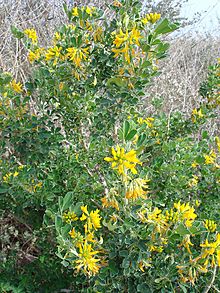| Medicago arborea | |
|---|---|

| |
| Scientific classification | |
| Kingdom: | Plantae |
| Clade: | Tracheophytes |
| Clade: | Angiosperms |
| Clade: | Eudicots |
| Clade: | Rosids |
| Order: | Fabales |
| Family: | Fabaceae |
| Subfamily: | Faboideae |
| Genus: | Medicago |
| Species: | M. arborea
|
| Binomial name | |
| Medicago arborea L. (1753)
| |
| Subspecies[1] | |
|
3; see text | |
| Synonyms[1] | |
| |
Medicago arborea is a flowering plant species in the pea and bean family Fabaceae. Common names include moon trefoil, shrub medick, alfalfa arborea, and tree medick. It is native to several Mediterranean Basin countries – Spain and the Balearic Islands, Italy including and Sardinia and Sicily, Greece including Crete and the East Aegean Islands, and Turkey.[1] It primarily grows on rocky shores among shrubby vegetation. It forms a symbiotic relationship with the bacterium Sinorhizobium meliloti, which is capable of nitrogen fixation. It is the only member of the genus Medicago which is used as an ornamental. M. arborea is sometimes misidentified as Cytisus, which it resembles.[2]
- ^ a b c "Medico arborea L." Plants of the World Online. Royal Botanic Gardens, Kew. Retrieved 26 August 2024.
- ^ Lesinš, Karlis Adolfs; Lesinš, Irma (1979). Genus Medicago (Leguminosae). The Hague, The Netherlands: Dr. W. Junk bv Publishers. p. 132. ISBN 90-6193-598-9.